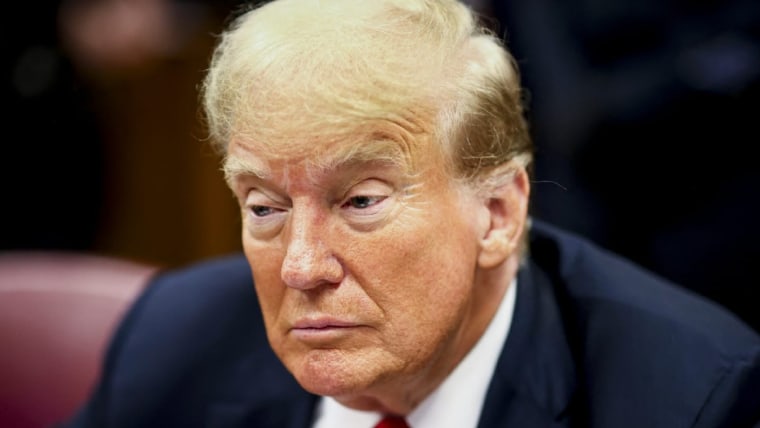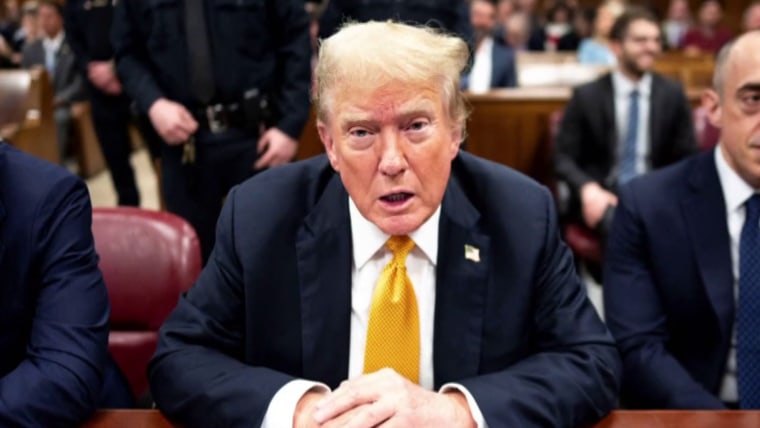Just minutes after the jury in Donald Trump’s Manhattan trial exited the courtroom Wednesday to begin deliberating, the former president picked up his phone. He quickly began posting up a storm on Truth Social, the social media site he owns, about the instructions the jury had just received. And, surprising nobody, the claims he and his allies are making are entirely off base.
“I don’t even know what the charges are in this rigged case — I am entitled to specificity just like anyone else,” Trump posted (in all caps). “There is no crime!” But Judge Juan Merchan had spent over an hour providing the jury with detailed instructions about what their deliberations entail. They included a thorough rundown of the counts the defendant faces and the laws underpinning the charges. It’s entirely possible that Trump had tuned out the details while resting his eyes, but the instructions were very clear about what the jury was deliberating.
It’s entirely possible that Trump had tuned out the details while resting his eyes, but the instructions were very clear about what the jury was deliberating.
That clarity didn’t stop Sen. Marco Rubio, R-Fla., from jumping on X to completely distort Merchan’s charge to the jurors. He claimed that Merchan “told the jury they don’t have to unanimously agree on which crime was committed as long as they all at least pick one,” and he compared the proceedings to “the kind of sham trial used against political opponents of the regime in the old Soviet Union.” George Washington University law professor Jonathan Turley, a favorite legal commentator in Trump’s world, also wrote on X that the jurors were told they “can disagree on what the crime was” among three options, adding that “this means that they could split 4-4-4 and he will still treat them as unanimous.”
Granted, the law that’s in play is an unusual one that left some legal experts skeptical about how it’s being applied. Trump is charged with 34 counts of falsifying business records in the first degree. He is accused of covering up the reimbursement payments he made to his then-lawyer Michael Cohen, who testified against his former boss at trial. Ahead of the 2016 election, Cohen paid $130,000 to porn star Stormy Daniels to keep silent about the affair she alleges she had with Trump. The cover-up of the reimbursement encompasses one part of the charge: the altering of records.

But here’s where it gets tricky — and where Trump and his allies have been quick to exploit the potential confusion. The prosecution bumped what would otherwise be a misdemeanor up to a felony by alleging that each of those 34 records was altered “with intent to defraud that includes an intent to commit another crime or to aid or conceal the commission” of that other crime. The crime allegedly being covered up is a violation of a state election law that makes it illegal for “two or more persons [to] conspire to promote or prevent the election of any person to a public office by unlawful means” and then to act upon that conspiracy.
The prosecution offered up three theories of the “unlawful means” that would violate the state election law: potential violations of the Federal Election Campaign Act, falsifying other business records or dodging tax laws. Crucially, the prosecution didn’t have to prove that those specific crimes occurred beyond a reasonable doubt, just that business records were falsified to try to hide breaking New York state election law through one of those possible avenues.
To break it down further, let’s say the jury is deliberating the eighth count, which concerns an April 2017 invoice from Cohen that the Trump Organization kept as a record. Suppose some of the jurors believe that the invoice was falsified to cover-up a violation of the FECA but the others think it was done to hide other business documents that were falsified to help swing the election. Under the jury instructions, that doesn’t matter: “Although you must conclude unanimously that the defendant conspired to promote or prevent the election of any person to a public office by unlawful means, you need not be unanimous as to what those unlawful means were.”
In other words, so long as all 12 jurors agree that the April 2017 invoice was altered and that it was done to conceal the conspiracy to boost Trump’s election chances, he is guilty. But if any of them has a reasonable doubt that the invoice was changed to commit, aid or conceal a conspiracy to violate state election law, he can’t be found guilty of that specific count.
Yes, this is a more complicated case, legally speaking, than some of the others Trump faces. (I had to ask my colleague Jordan Rubin to triple-check that I was explaining the instructions correctly.) But it doesn’t excuse Rubio’s faux outrage or Trump’s false claim that the judge is “not requiring a unanimous decision on the fake charges against me.” Turley is a law professor, Rubio has a law degree, and both (at least in theory) know how to parse the law. Likewise, Trump’s lawyers and prosecutors both had chances to pitch their own versions of jury instructions to Merchan. They also got notice last week of the orders Merchan would read out, giving them plenty of time to brief their clients.
What we’re seeing, then, can’t be excused by confusion over unclear directions from Merchan or a lack of legal knowledge from laymen. Instead, in pretending the instructions are a clear deviation from the familiar standard for conviction, Trump and his allies are attempting to undercut a potential guilty verdict and falsely shore up his claims that the whole process has been rigged against him. Moreover, it’s a clear effort to muddy the waters among casual, low-information voters who might be swayed against supporting him in the event of a conviction. But without a more active pushback from the judge and legal experts, the simple fiction that Trump is selling might be more easily digestible than the complicated truth.

